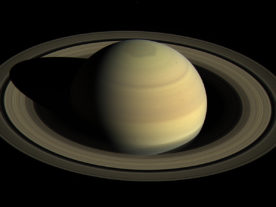It is springtime at the South Pole. The sun sits low on the horizon and bathes the landscape in rich hues of yellow and orange. Light bounces off each imperfection in the Polar Plateau, each wrinkle of snow and pinnacle of ice is set aglow. It transforms the ice cap from frozen desert to an endless field of what looks like wild flowers at the height of bloom.
High above, long thin wispy clouds crawl across the light blue sky. It is a peaceful scene and if it weren’t for the biting cold, one could almost imagine unfurling a blanket and enjoying an afternoon picnic of expensive cheeses and absinthe.

At 12:30 a.m., an early morning at ARO. (Photo by Kyle Obrock)
But with spring’s beauty also comes destruction. The ozone hole has begun to form—a springtime phenomenon in which the ozone layer over Antarctica is reduced to one-half its normal thickness.
Ozone destruction is not unique to the polar continent; it takes place wherever ozone-depleting substances—such as old refrigerants and aerosols—exist in the atmosphere. This is to say, all over the planet. What makes ozone destruction in Antarctica unique is the extent of the phenomenon, the magnitude and rate at which it occurs.
To better understand the seasonal depletion of ozone over the South Pole, it’s important to understand the general principles behind ozone destruction everywhere else.
Ozone is a molecule made up of three oxygen molecules bound together. It can be found throughout the atmosphere, from the surface of the planet to the top of the stratosphere. The ozone layer is the region of the atmosphere where it is most heavily concentrated, typically at an altitude of 20-to-30 kilometers (12-to-18 miles). It acts as the earth’s sunscreen, protecting us from too much ultraviolet radiation from the sun.
When man-made, ozone-depleting substances come in contact with ozone under the presence of sunlight, ozone is destroyed. A single molecule of an ozone-depleting substance can destroy over 100,000 ozone molecules before it is rendered inactive or removed from the atmosphere.

A composite image of the first few seconds of an ozonesonde balloon launch. The balloon will stay afloat for more than two hours. (Photo: C. Krueger)
Since sunlight is required for the ozone destruction to take place, the ozone layer over Antarctica remains relatively unaffected during the dark winter months. However, when the sun begins to rise in early September, the story changes and we begin seeing ozone destruction in earnest. Of course, if light were the only other part of the equation, why is ozone depletion so much more pronounced here, especially during the months of September and October?
As it turns out, two other phenomena occur during the Antarctic spring that intensify the formation of the ozone hole.
One is the development of polar stratospheric clouds, which can convert man-made chemicals into more destructive forms. PSCs can only form when temperatures are extremely cold, below minus 62 Celsius (-80F). The only place in the world where temperatures get this low is Antarctica, and consequently it’s one of the reasons we don’t see an ozone hole form over the North Pole.
The second phenomena is the springtime polar vortex. The seasonal weather system envelopes the continent and keeps ozone-rich air from the southern hemisphere from flooding in and rebuilding the ozone layer.
At the Atmospheric Research Observatory (ARO), we take ozone measurements using a variety of instruments throughout the year. Over the next eight weeks, however, as the ozone hole forms, our regimen of observations will increase.

It takes close to two weeks to condition an ozonesonde for deployment. Above, an ozone generating machine is used to test the instrument for accuracy. (Photo: R. Klein)
Weather balloons carrying a special measuring instrument called an ozonesonde form the cornerstone of our research. The balloons carry the ozonesondes upwards of 40 kilometers (25 miles) into the sky, collecting continuous measurements of ozone, which they transmit back to our computers via a radio signal.
When the balloon pops, after several hours of ascent, a parachute attached the ozonesonde is deployed, and additional readings of the ozone profile are taken during its descent. With both ascent and descent profiles of the ozone distribution, we are able to accurately describe the shape and size of the ozone hole on a day-by-day basis.
Change is hard to witness at the South Pole. The ice cap remains the ice cap; the silence is only punctured by the occasional gust of wind or the insistent drone of the power plant. Springtime is perhaps the one exception, the one time of the year that change can be witnessed on a daily basis. From the ever-brightening skies, to the brighter moods on station, and upwards to the stratosphere, where over the course of a few months, we witness the ozone layer’s annihilation and then rebirth.






















Thanks for the information provided
and the need to abandon the illusion CFC.
I’m confused. I was under the impression that ozone is created by the sun’s rays bombarding the atmosphere, so there’s more ozone during the daytime and during the summer when the sunshine is most direct. The ozone naturally decays into normal O2 at night and during the winter. Ya mean I’ve misunderstood this for the past sixty-five years? Holy moly!